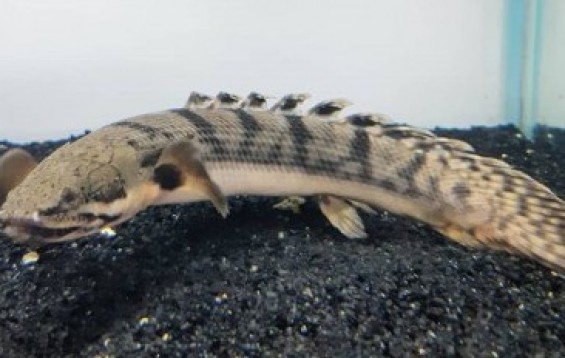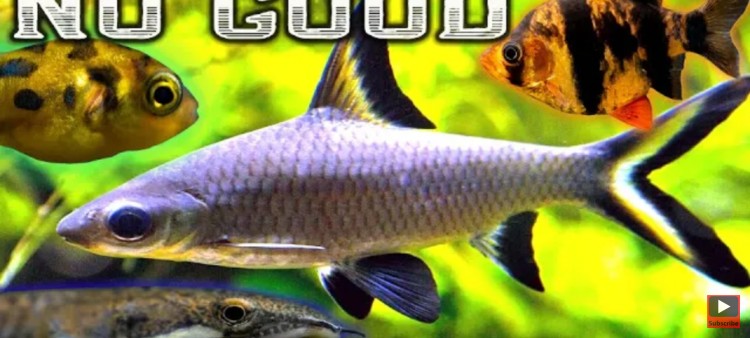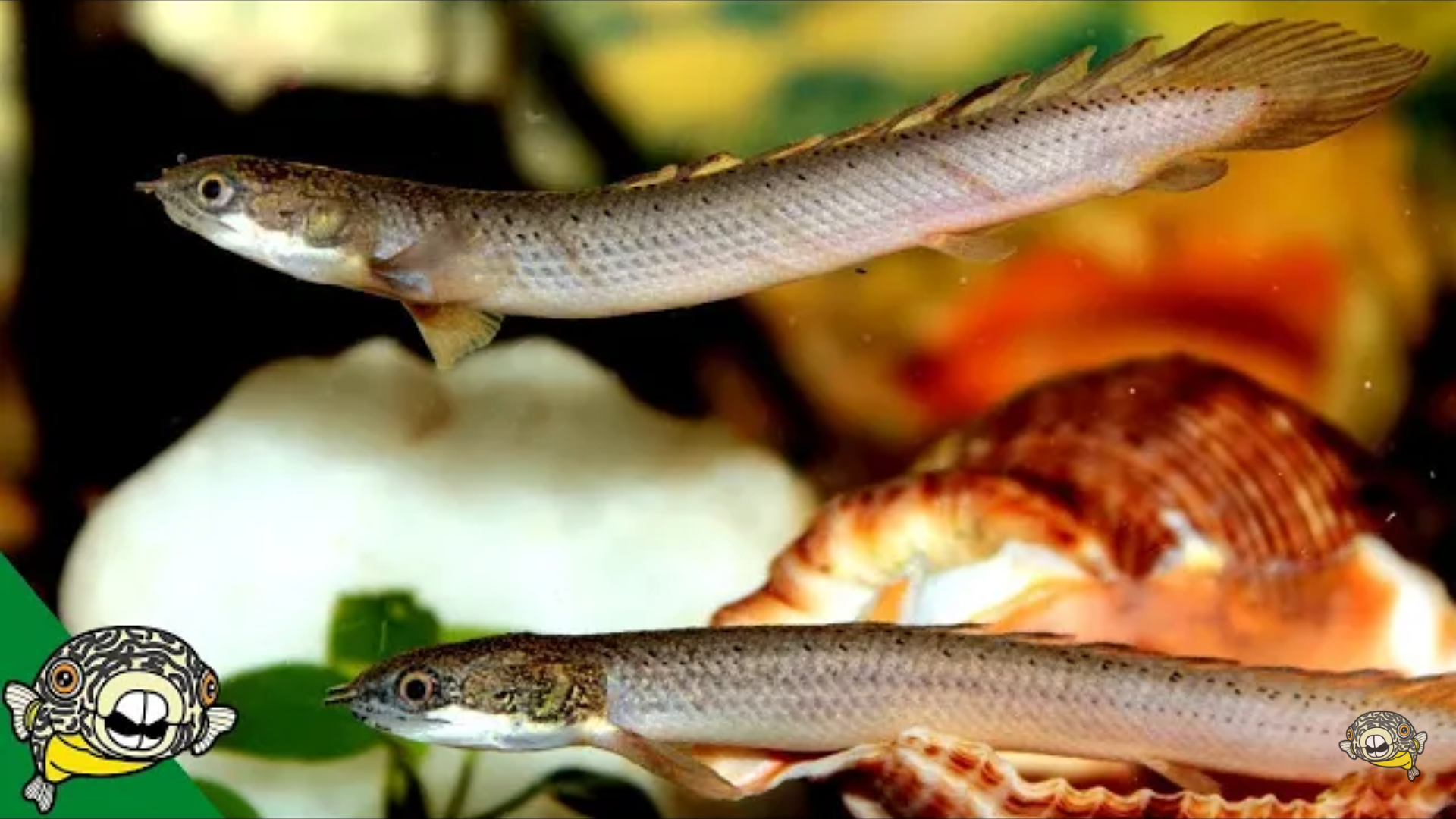- Name:
Weeksii Bichir
(View AKA's) - Family: Polypteridae
- Species: Bichir
- Scientific Name: Polypterus weeksii


General info about Weeksii Bichir
The Weeksii Bichir is also known as the Mottled or Fatheaded Bicher. The latter nickname is due to its very large head. It is snakelike in shape with a greyish-green dorsal surface color, with black banding that may fork towards the bottom. The ventral surface is white. This species retains external gills much longer than most other Polypterus species, and the upper jaw is longer or equal in length to the lower jaw. Their approximate purchase size is 3 to 7 inches, and the average adult is 54 cm (22 inches).
As with other members of the primitive Polypteridae family, the Weeksii Bichir has the unique ability to survive out of water. It has a lung-like, paired swim bladder and gills for breathing. It can spend short periods of time on land, but must soon return to its water environment for adequate respiration. These features clearly exhibit the link these species form between fish and amphibians.
Their pectoral fins are used for crawling when out of water and for mobility when on the bottom of the aquarium. It thrives best in a densely planted, dimly lit aquarium, with plenty of sandy or fine gravel bottom space. A few pieces of driftwood, caves, and rocks would be good for hiding places. They also appreciate dense vegetation that is well rooted other wise a large bichir will eventually uproot and destroy them. Since Bichirs are mainly nocturnal they do not like bright lighting.
When provided with plenty of open swimming areas, rocks and crevices, and dense cover the Weeksii Bichir is not usually aggressive toward tank mates. This species is semi-aggressive considering that they will swallow any fish or invertebrate that they can fit into their mouth, if given the chance. They are only a threat to fish smaller than themselves. They are also prone to jumping and escaping, so a tight, well-sealed aquarium lid is required.
They are one of the rarer Bichir species, available on a seasonal basis from specialty tropical fish keeping shops and online. They are not a common stock item in most shops.
Weeksii Bichir Diet & Nutrition
Adult Weeksii Bichirs are carnivorous fish requiring a live food in their diet. It is easy to feed and will generally accept a quality carnivore pellet or stick. They do, however, prefer live or frozen foods such as mysis shrimp, brine shrimp, chopped beef heart, bloodworms, chunks of raw fish, earthworms, blackworms or fresh market shrimp. They should be fed once or twice a day as much as they can consume in five minutes. Due to their poor eyesight, slow movements, and nocturnal nature, they should be fed in the evening just before turning off the aquarium light. Their well-developed sense of smell gives them an advantage over their tank mates when eating at night.
Determining Sex of Weeksii Bichir
Males have a thicker anal fin than females of the species and are usually a bit smaller.
Breeding & Spawning Weeksii Bichir
There is no recorded breeding of this species in captivity, though it is thought to reproduce in a way similar to other Polypterus species. In nature, they reproduce during the rainy season. Changes in temperature and slightly acidic water likely induce courtship and mating. Courtship involves the male chasing and nudging the female. During spawning, the male collects the eggs from the female by cupping his anal and caudal fins around her genitals. Then he then fertilizes the eggs before scattering them amongst vegetation. Areas of dense vegetation or spawning mops should be provided for this reason. After spawning, adult fish should be removed as they may eat the eggs. The eggs will hatch in 3 - 4 days. The juveniles will become free swimming approximately three days later. First foods should be microworms or newly hatched baby brine shrimp. Since the juveniles are not particularly mobile, use and eye dropper to ensure they are well fed. P. weeksii retains the external gills for much longer than other members of the genus. The reason for this is unknown.
Common Diseases with Weeksii Bichir
Most are wild caught and could carry parasites or have infections so it is advisable to keep them isolated until given a clean bill of health.
Weeksii Bichir Origin
Congo River Basin, Central Africa.
Original Detail
| Name | Species | Family | Scientific Name | More Detail | Added by |
|---|---|---|---|---|---|
| Weeksii Bichir | Bichir | Polypteridae | Polypterus weeksii | The Weeksii Bichir is also known as the Mottled or Fatheaded Bicher. The latter nickname is due to its very large head. It is snakelike in shape with a greyish-green dorsal surface color, with black banding that may fork towards the bottom. The ventral surface is white. This species retains external gills much longer than most other Polypterus species, and the upper jaw is longer or equal in length to the lower jaw. Their approximate purchase size is 3 to 7 inches, and the average adult is 54 cm (22 inches). As with other members of the primitive Polypteridae family, the Weeksii Bichir has the unique ability to survive out of water. It has a lung-like, paired swim bladder and gills for breathing. It can spend short periods of time on land, but must soon return to its water environment for adequate respiration. These features clearly exhibit the link these species form between fish and amphibians. Their pectoral fins are used for crawling when out of water and for mobility when on the bottom of the aquarium. It thrives best in a densely planted, dimly lit aquarium, with plenty of sandy or fine gravel bottom space. A few pieces of driftwood, caves, and rocks would be good for hiding places. They also appreciate dense vegetation that is well rooted other wise a large bichir will eventually uproot and destroy them. Since Bichirs are mainly nocturnal they do not like bright lighting. When provided with plenty of open swimming areas, rocks and crevices, and dense cover the Weeksii Bichir is not usually aggressive toward tank mates. This species is semi-aggressive considering that they will swallow any fish or invertebrate that they can fit into their mouth, if given the chance. They are only a threat to fish smaller than themselves. They are also prone to jumping and escaping, so a tight, well-sealed aquarium lid is required. They are one of the rarer Bichir species, available on a seasonal basis from specialty tropical fish keeping shops and online. They are not a common stock item in most shops. |
PalaciosAn |
Changed by users
| Submitted Date | Submitted By | Status | Action |
|---|



